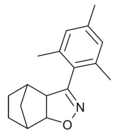SN-2
SN2 Reaction
The SN2 reaction (or bimolecular nucleophilic substitution reaction) is a type of reaction mechanism that is common in organic chemistry. In this mechanism, one bond is broken and one bond is formed synchronously, i.e., in one step. SN2 is a kind of nucleophilic substitution, or attack by a nucleophile on an electron-deficient part of another molecule.
Mechanism[edit]
The SN2 reaction mechanism involves the direct, simultaneous attack of a nucleophile on a substrate and expulsion of a leaving group. The mechanism is called 'SN2' because of its nature: 'S' stands for 'substitution', 'N' for 'nucleophilic', and '2' for 'bimolecular' (referring to the overall molecularity of the reaction).
The reaction occurs in a single step with simultaneous bond formation and bond breaking, leading to inversion of the stereochemical configuration. In the course of the reaction, the substrate passes through a transition state in which it is pentacoordinate and approximately trigonal bipyramidal. The nucleophile attacks from the side opposite to the leaving group.
Factors Affecting SN2 Reactions[edit]
Several factors can affect the rate and outcome of SN2 reactions, including the strength of the nucleophile, the solvent, the leaving group, and the substrate structure.
Nucleophile[edit]
In an SN2 reaction, the nucleophile plays a crucial role. A good nucleophile is one that is a strong base or has a negative charge. The nucleophilicity of a species is also affected by the solvent; polar aprotic solvents are better for SN2 reactions because they do not solvate nucleophiles, allowing them to react faster.
Solvent[edit]
The choice of solvent can greatly affect the rate of SN2 reactions. Polar aprotic solvents, such as acetone or DMSO, are generally the best choice for these reactions. These solvents can solvate the leaving group, increasing the rate of the reaction.
Leaving Group[edit]
A good leaving group is crucial for a successful SN2 reaction. The leaving group must be able to stabilize the extra electrons once it has left the molecule. Halides and tosylates are common leaving groups for SN2 reactions.
Substrate Structure[edit]
The structure of the substrate can also greatly affect the rate of SN2 reactions. The reaction rate is fastest with primary substrates and slowest with tertiary substrates due to steric hindrance.
Stereochemistry[edit]
SN2 reactions result in inversion of configuration at the carbon atom undergoing nucleophilic substitution. This is known as the Walden inversion. If the substrate is chiral, the SN2 reaction can produce an enantiomerically pure product.
See Also[edit]
This article is a Organic reaction-related stub. You can help WikiMD by expanding it!
SN-2[edit]
-
SN-2 structure
Ad. Transform your life with W8MD's Budget GLP-1 injections from $75


W8MD offers a medical weight loss program to lose weight in Philadelphia. Our physician-supervised medical weight loss provides:
- Weight loss injections in NYC (generic and brand names):
- Zepbound / Mounjaro, Wegovy / Ozempic, Saxenda
- Most insurances accepted or discounted self-pay rates. We will obtain insurance prior authorizations if needed.
- Generic GLP1 weight loss injections from $75 for the starting dose.
- Also offer prescription weight loss medications including Phentermine, Qsymia, Diethylpropion, Contrave etc.
NYC weight loss doctor appointmentsNYC weight loss doctor appointments
Start your NYC weight loss journey today at our NYC medical weight loss and Philadelphia medical weight loss clinics.
- Call 718-946-5500 to lose weight in NYC or for medical weight loss in Philadelphia 215-676-2334.
- Tags:NYC medical weight loss, Philadelphia lose weight Zepbound NYC, Budget GLP1 weight loss injections, Wegovy Philadelphia, Wegovy NYC, Philadelphia medical weight loss, Brookly weight loss and Wegovy NYC
|
WikiMD's Wellness Encyclopedia |
| Let Food Be Thy Medicine Medicine Thy Food - Hippocrates |
Medical Disclaimer: WikiMD is not a substitute for professional medical advice. The information on WikiMD is provided as an information resource only, may be incorrect, outdated or misleading, and is not to be used or relied on for any diagnostic or treatment purposes. Please consult your health care provider before making any healthcare decisions or for guidance about a specific medical condition. WikiMD expressly disclaims responsibility, and shall have no liability, for any damages, loss, injury, or liability whatsoever suffered as a result of your reliance on the information contained in this site. By visiting this site you agree to the foregoing terms and conditions, which may from time to time be changed or supplemented by WikiMD. If you do not agree to the foregoing terms and conditions, you should not enter or use this site. See full disclaimer.
Credits:Most images are courtesy of Wikimedia commons, and templates, categories Wikipedia, licensed under CC BY SA or similar.
Translate this page: - East Asian
中文,
日本,
한국어,
South Asian
हिन्दी,
தமிழ்,
తెలుగు,
Urdu,
ಕನ್ನಡ,
Southeast Asian
Indonesian,
Vietnamese,
Thai,
မြန်မာဘာသာ,
বাংলা
European
español,
Deutsch,
français,
Greek,
português do Brasil,
polski,
română,
русский,
Nederlands,
norsk,
svenska,
suomi,
Italian
Middle Eastern & African
عربى,
Turkish,
Persian,
Hebrew,
Afrikaans,
isiZulu,
Kiswahili,
Other
Bulgarian,
Hungarian,
Czech,
Swedish,
മലയാളം,
मराठी,
ਪੰਜਾਬੀ,
ગુજરાતી,
Portuguese,
Ukrainian
